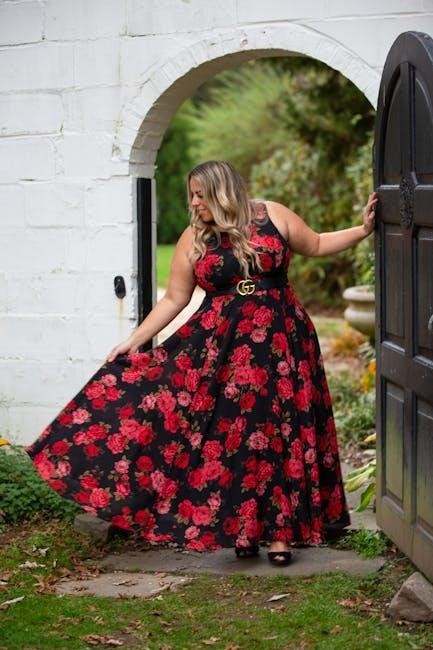Welcome to our comprehensive belt size guide! Learn how to choose the perfect belt size for comfort and style, avoiding common mistakes and ensuring a tailored fit.
1.1 Importance of Proper Belt Fit
A proper belt fit ensures both comfort and functionality, preventing discomfort from a belt that’s too tight or too loose. It also enhances your outfit’s aesthetic appeal by creating a polished look. A well-fitting belt supports your pants securely, maintaining proper posture and reducing the risk of wardrobe malfunctions. Additionally, it prevents excessive wear on clothing from constant adjustments. Choosing the right size is crucial, as an ill-fitting belt can lead to discomfort throughout the day. A belt that fits correctly allows for slight adjustments, accommodating changes in body size while maintaining reliability and style over time.
1.2 Common Mistakes in Choosing Belt Size
One common mistake is assuming your belt size matches your pant size, which isn’t always accurate due to differences in materials and vanity sizing. Another error is measuring incorrectly, such as including the buckle or not considering where the belt will sit. Relying solely on the “add two inches” rule can also lead to sizing issues, as body shapes and preferences vary. Additionally, some individuals overlook brand-specific measurements, resulting in belts that are too tight or too loose. Avoid these pitfalls by measuring carefully and consulting size charts to ensure a perfect fit for comfort and style.

How to Measure Your Belt Size
To accurately determine your belt size, measure around your natural waistline or through your pants’ belt loops for a precise, comfortable fit.
2.1 Measuring with a Tape Measure

To measure your belt size with a tape measure, wrap it around your natural waistline or through your pants’ belt loops. Ensure the tape is snug but not tight, and note the measurement. For accuracy, pull the tape so it rests flat against your body without twisting. If measuring for a specific outfit, wear it while taking the measurement. This method provides a precise fit, as it directly reflects your waist size. Remember, your belt size may differ from your pant size, so always measure rather than guess for the best results.
2.2 Using an Existing Belt for Measurement
If you have a belt that fits comfortably, you can use it to determine your size. Lay the belt flat and measure from the end of the buckle to the most used hole. This measurement will give you your belt size. While this method is convenient, it’s less precise than using a tape measure, as belts can stretch or vary by brand. For the most accurate fit, combining this with a tape measure is recommended. This ensures your new belt aligns with your body’s measurements, providing comfort and a tailored look.
2.3 Differences Between Hip and Waist Belts
Hip and waist belts differ in where they are worn. Waist belts are designed to sit at the natural waistline, typically 1-2 inches above the belly button, while hip belts are worn lower, around the hip bones. To measure for a waist belt, wrap the tape measure around your natural waistline. For a hip belt, measure around the widest part of your hips. Waist belts tend to run smaller than hip belts, so your size may differ by 2-3 inches depending on where you wear it. Always measure at the intended wearing location for the most accurate fit.

Understanding Belt Size vs. Pant Size
Belt size differs from pant size due to material stretch and vanity sizing. The “add two inches” rule is common, but direct measurement ensures the best fit.
3.1 The “Add Two Inches” Rule
The “add two inches” rule is a common guideline for determining belt size. It suggests that your belt size is typically two inches larger than your pant size. For example, if your pants are a size 32, your belt size would be 34; This rule accounts for the natural stretch of materials and ensures a comfortable fit. However, this method may not always be accurate due to variations in brand sizing and personal preferences. Measuring your waist directly is often more reliable for a precise fit.
3.2 Why Pant Size Alone Isn’t Reliable
Relying solely on pant size for choosing a belt can lead to inaccuracies. Pants sizes vary between brands due to vanity sizing and differences in materials, which can stretch or shrink over time. Additionally, pants may sit at different heights on the body, affecting the belt placement. A pant size of 32 inches might not always translate to a belt size of 34 inches, as some brands may cut their pants larger or smaller. Measuring your waist directly ensures a more accurate and comfortable fit, making it the preferred method for determining belt size.
Choosing the Right Belt Size
Selecting the perfect belt size involves measuring your waist and considering the “add two inches” rule, while also accounting for brand-specific sizing variations to ensure a comfortable fit.
4.1 General Sizing Tips
Accurate measurement is key to selecting the right belt size. Use a tape measure to determine your natural waistline or where the belt will sit. Add 2 inches to your pant size for a reliable estimate. If your waist measures 34 inches, opt for a 36-inch belt. Consider brand-specific sizing, as some brands may vary. Choose a belt that allows the buckle to sit in the middle hole for optimal adjustability. Leather belts may stretch slightly over time, so starting snug but not tight is ideal. Always refer to size charts and product descriptions for precise fitting guidance.
4.2 Considering Brand-Specific Measurements
Brand-specific sizing can vary significantly, so always check the manufacturer’s size chart before ordering. Some brands include the buckle in their measurements, while others measure from the leather end to the most used hole. If unsure, compare your waist size to their chart. Leather belts may stretch over time, so starting snug but not tight is ideal. Custom-size options are available from some brands, allowing precise fits. Always review product descriptions for specific sizing guidelines, as standard rules may not apply. This ensures the best fit and comfort for your unique needs.
Customizing Your Belt Fit
Customizing your belt ensures a tailored fit, offering precise measurements to suit your waist size. This option is ideal for those seeking a personalized and comfortable accessory.
5.1 How to Order a Custom Belt
Ordering a custom belt involves precise measurements for the best fit. Start by measuring your natural waistline or where you intend to wear the belt. Use a tape measure, ensuring it’s snug but not tight. Note your measurement to the nearest quarter inch for accuracy. Next, choose a size option labeled as “Custom” or “Tailored Fit” when selecting your belt. Provide your exact measurement in the designated section, often required by brands offering bespoke options. Some brands may also ask for your preferred buckle style or additional features. This ensures your belt is crafted specifically to your needs, offering a perfect fit and lasting comfort. Proper measurement and clear communication with the seller are key to a successful custom order. By following these steps, you can enjoy a belt that not only fits perfectly but also complements your personal style effortlessly. This personalized approach ensures that your belt is both functional and fashionable, catering precisely to your body shape and preferences. With a custom belt, you eliminate the guesswork of standard sizing, making it an ideal choice for those seeking a flawless fit. The process is straightforward, and the end result is well worth the extra attention to detail. Whether for everyday wear or special occasions, a custom belt offers unparalleled comfort and style, making it a worthwhile investment for anyone looking to elevate their wardrobe accessories. The ability to specify exact measurements ensures that your belt will be tailored to your unique proportions, providing a secure and comfortable fit that standard sizes simply can’t match. Additionally, many brands offer the option to choose from various materials and finishes, allowing you to further personalize your belt to suit your aesthetic preferences. This level of customization not only enhances the functionality of the belt but also adds a touch of individuality to your outfit. By opting for a custom belt, you’re investing in a product that is designed specifically for you, ensuring a perfect blend of form and function. The process may take a bit more time and effort than purchasing a standard belt, but the superior fit and personalized touches make it a rewarding experience. Furthermore, a well-crafted custom belt is likely to be more durable, as it is made with attention to detail and high-quality materials. This durability, combined with the perfect fit, makes a custom belt a practical and stylish addition to your wardrobe. In conclusion, ordering a custom belt is a simple yet effective way to ensure that your accessory meets your specific needs and preferences, providing a comfortable and fashionable solution for years to come.
5.2 Benefits of a Tailored Fit
A tailored fit offers numerous advantages, ensuring your belt provides optimal comfort and style. With a custom-made belt, you enjoy a precise measurement that aligns perfectly with your waist or hip size, eliminating gaps or tight spots. This personalized approach allows for a few holes bigger and smaller, accommodating potential body changes. A tailored fit also enhances durability, as the belt isn’t strained or stretched unevenly. Additionally, it elevates your personal style, ensuring the belt complements your outfit seamlessly. Overall, a tailored fit combines comfort, functionality, and aesthetics, making it a worthwhile investment for lasting quality and personal satisfaction.

Belt Care and Maintenance
Proper care ensures your belt lasts longer. Clean leather belts with a soft cloth and avoid harsh chemicals. Store belts flat or hanging to prevent bending and damage.
6.1 Cleaning and Conditioning Leather Belts
To extend the life of your leather belt, clean it gently with a soft, damp cloth. Avoid harsh chemicals or abrasive materials, as they can damage the leather. For deeper cleaning, use a leather-specific cleaner, applying it evenly with a clean cloth. Allow the belt to dry naturally, away from direct sunlight. Conditioning is essential to maintain suppleness and prevent cracking. Use a high-quality leather conditioner, rubbing it in with a circular motion. Let it sit before buffing with a clean cloth for a polished finish. Regular maintenance ensures your belt remains durable and stylish over time.
6.2 Storing Belts Properly
Proper storage is key to maintaining the quality of your belts. Store them in a cool, dry place away from direct sunlight to prevent fading or cracking. Avoid folding or bending leather belts, as this can cause creases or damage. Instead, lay them flat or hang them using a sturdy hook or belt hanger; For travel, consider using a protective pouch or case to shield belts from dust and moisture. Avoid stacking multiple belts on top of each other, as this can lead to warping. Regularly inspect stored belts for signs of wear or pests to ensure they remain in excellent condition.
